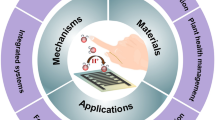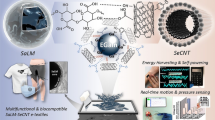Abstract
The blossoming research field of electronic textiles (or e-textiles) seeks to integrate ubiquitous electronic and computational elements into fabric. This paper concerns one of the most challenging aspects of the design and construction of e-textile prototypes: namely, engineering the attachment of traditional hardware components to textiles. We present three new techniques for attaching off-the-shelf electrical hardware to e-textiles: (a) the design of fabric PCBs or iron-on circuits to attach electronics directly to a fabric substrate; (b) the use of electronic sequins to create wearable displays and other artifacts; and (c) the use of socket buttons to facilitate connecting pluggable devices to textiles. In this work we have focused on using easily obtained materials and developing user-friendly techniques; our aim is to develop methods that will make e-textile technology available to crafters, students, and hobbyists. This paper describes the techniques and employs them as a springboard for a wider-ranging discussion of “e-textile craft”.

















Similar content being viewed by others
References
Lee J, Subramanian V (2005) Weave patterned organic transistors on fiber for E-textiles. IEEE Trans Electron Dev 52:269–275
Bonfiglio A et al. (2005) Organic field effect transistors for textile applications. IEEE Trans Inf Technol Biomed 3(9):319–324
Maccioni M et al. (2006) Towards the textile transistor: assembly and characterization of an organic field effect transistor with a cylindrical geometry. Appl Phys Lett 89:143–515
Weiser M (1991) The computer for the 21st century. Sci Am 265(3):94–104
Service R (2003) Technology: electronic textiles charge ahead. Science 201(5635):909–911
Tröster G (2005) The agenda of wearable healthcare. The IMIA yearbook of medical informatics 2005: Ubiquitous Health Care Systems, pp 125–138
Pacelli M (2006) Sensing fabrics for monitoring physiological and biomechanical variables: E-textile solutions. In: Proceeding of the 3rd IEEE EMBS international summer school and symposium on medical devices and biosensors, Boston, MA
Wilson P (2005) Textiles from novel means of innovation. In: McQuaid M (ed). Extreme textiles: designing for high performance. Princeton Architectural Press, New York, pp 180–213
The Georgia Tech Wearable Motherboard: The intelligent garment for the 21st century. Available: http://www.smartshirt.gatech.edu
Park S, Mackenzie K, Jayaraman S (2002) Wearable motherboard: a Framework for personalized mobile information processing (PMIP). In: Design automation conference (DAC), New Orleans
Vivometrics. Available: http://www.vivometrics.com
Cottet D et al (2003) Electrical characterization of textile transmission lines. IEEE Trans Adv Packaging 26(2):182–190
Dunne L et al (2006) Garment-based body sensing using foam sensors. In: Proceedings of the Australasian user interface conference
Linz T et al (2005) Embroidering electrical interconnects with conductive yarn for the integration of flexible electronic modules into fabric. In: Proceedings of International symposium on wearable computers (ISWC), Osaka, Japan
Orth M (2002) Defining flexibility and sewability in conductive yarns. Proc Mat Res Soc Symp (MRS) 736:37–48
Post E et al (2000) E-Broidery: design and fabrication of textile based computing. IBM Syst J 39(3–4):840–860
Edmison J et al (2002) Using piezoelectric materials for wearable electronic textiles. In: Proceedings of international symposium on wearable computers (ISWC), Seattle
Wakita A, Shibutani M (2006) Mosaic textile: wearable ambient display with non-emissive color-changing modules. In: Proceedings of the international conference on advances in computer entertainment technology (ACE), Hollywood
International Fashion Machines. Available: http://www.ifmachines.com
Berzowska J (2005) Electronic textiles: wearable computers, reactive fashion, and soft computation. Textile 3(1):2–19
Cutecircuit. Available: http://www.cutecircuit.com/
Less EMF. Available: http://www.lessemf.com/fabric.html
Kallmayer C et al. (2003) New assembly technologies for textile transponder systems. In: 53rd electronic components and packaging conference (ECTC), New Orleans
Buechley L. DIY: Make your own electronic sewing kit and materials links. Available: http://www.cs.colorado.edu/∼buechley
Slade J et al (2002) Washing of electrotextiles. Proc Mat Res Soc Symp (MRS) 736:99–108
Owner’s Manual, 42-Range Digital Multimeter #22–811. Available: http://rsk.imageg.net/graphics/uc/rsk/Support/ProductManuals/2200811_PM_EN.pdf
Lehn D (2004) e-TAGs: e-textile attached gadgets. In: Proceedings of communication networks and distributed systems (CNDS), San Diego
Tröster G et al (2003) Wearable computing: packaging in textiles and clothes. In: Proceedings of the 14th European microelectronics and packaging conference (EMPC), Firedrichshafen, Germany
Locher I et al (2004) Routing methods adapted to e-textiles. In: Proceedings of 37th international symposium on microelectronics (IMAPS), Long Beach
Buechley L, Elumeze N, Eisenberg M (2006) Electronic/computational textiles and children’s craft. In: Proceedings of interactive design and children (IDC), Tampere, Finland
Buechley L et al (2005) Quilt snaps: a fabric based computational construction kit. In: International workshop on wireless and mobile technologies in education (WMTE), Tokushima, Japan
Toffoli T, Margolus N (1987) Cellular automata machines: a new environment for modeling. MIT Press, Cambridge
PicoCricket. Available: http://www.picocricket.com/
Basic Stamp. Available: http://www.parallax.com/
LogoChip. Available: http://www.wellesley.edu/Physics/Rberg/logochip/
Arduino. Available: http://www.arduino.cc/
Acknowledgments
Thanks to Nwanua Elumeze, Mark Gross, Colby Smith, Camille Dodson and Sue Hendrix for their advice, contributions and conversation. This work was funded in part by the National Science Foundation (awards no. EIA-0326054 and REC0125363).
Author information
Authors and Affiliations
Corresponding author
Rights and permissions
About this article
Cite this article
Buechley, L., Eisenberg, M. Fabric PCBs, electronic sequins, and socket buttons: techniques for e-textile craft. Pers Ubiquit Comput 13, 133–150 (2009). https://doi.org/10.1007/s00779-007-0181-0
Received:
Accepted:
Published:
Issue Date:
DOI: https://doi.org/10.1007/s00779-007-0181-0




